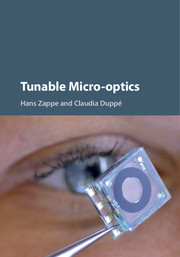2 - Tunable Optics in Nature
from Part I - Introduction
Published online by Cambridge University Press: 05 December 2015
Summary
Introduction
In general, Nature's optical solutions are characterized by a perfectly balanced adjustment between vital functionality and simplicity. In other words, evolution made sure that natural systems are only equipped with the absolute necessities. Nice-to-have features, i.e. additional but dispensable features, are generally amiss. The enormous diversity of visual perception systems found in the animal kingdom bears witness to Nature's wealth of solutions, which have evolved to reveal individual perfect adaption to various living condition. In many cases, the optimized visual system consists of a tailored combination of a simple basic optical system, which offers only limited optical performance, and variable, deformable, or movable components. It is only the combination of both optical characteristics and tunable functionality that provides living beings with an optimized and well-adapted visual overall system.
This is most strongly ascertained by our own, the human, visual perception system. If we consider only the image quality of the human eye, it must be said that the optical performance is rather moderate. The mere optical capability of high resolution is limited to a very small angle of about 1◦ and our eyes are very prone to significant chromatic aberrations. As early as the nineteenth century, the physiologist and physician Hermann von Helmholtz (1821–1894), whose research significantly contributed to the scientific understanding of the working principle of the human visual perception system, had already observed the poor imaging quality of the human eye and poked fun at its aberrations. He said: “Now, it is not too much to say that, if an optician wanted to sell me an instrument which had all these defects, I should think myself quite justified in blaming his carelessness in the strongest terms, and giving him back his instrument.” (Helmholtz 1893). In the same vein, he said: “Of course, I shall not do this with my eyes, and shall be only too glad to keep them as long as I can.”
It is the second part of Helmholtz's statement in particular that expresses our own subjective impression of the high quality of our “eyes.” Despite the objective fact of a strongly aberration-affected optical performance, the subjective overall impression offers a high-quality perception of the whole surrounding world.
- Type
- Chapter
- Information
- Tunable Micro-optics , pp. 38 - 64Publisher: Cambridge University PressPrint publication year: 2015
References
- 1
- Cited by



